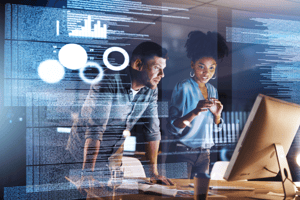digital twin metaverse
The metaverse, it isn’t just sci-fi anymore. Is your company ready?
The original T.V. show, Star Trek, was first broadcast 55 years ago. Over three seasons, which spawned a whole Star Trek canon of T.V. spin-offs and movies, they highlighted a range of technology, from flat screen T.V.s to flip phones to replicators. Because life often has a way of imitating art, many of these technologies are things we've seen become some kind of modern-day reality. Another iconic piece of science fiction is the 30-year-old book Snow Crash by Neal Stephenson. In it, Stephenson describes a virtual world called the metaverse. Snow Crash is a dark, cyberpunk imagining of a dystopian future L.A. and a hero who jumps from it back and forth into the metaverse. And just like the Universal Translators of Star Trek, the metaverse is no longer just the stuff of fiction.
While the catchy, trendy term "metaverse" has only recently started to be written about by business and strategy publications, the term actually embraces a bunch of technologies and concepts that have been around for a while: large-scale multiplayer games and virtual worlds, such as World of Warcraft and Second Life, have been around for decades. And virtual and augmented reality themselves are not new; they had their Peak of Inflated Expectations moment about five years ago. In today's parlance, the metaverse is "a virtual reality-based parallel internet world where users can interact with each other and digital objects in a 3D space. It's an extension of the internet into a three-dimensional virtual world. “ according to Forbes. It brings together a lot of technologies, from IoT to blockchain to VR/AR.
Recently, businesses have started paying attention, even if they’re still not sure what the metaverse will mean for their industries, employees, and customers. A recent PwC survey said that 82% of executives expect metaverse plans to be part of their business activities within three years. 66% say their companies are already engaged in some form, reporting that “they’ve moved beyond metaverse experimentation, and within a few years, most say their metaverse efforts will be fully integrated across the business.”
The host of potential business activities that might take place in the metaverse is too varied and early-stage to dive deep here. But common across many of the efforts so far is the creation of a digital twin of the company’s infrastructure and assets in the metaverse, whether it’s building virtual twins of their headquarters, factories, retail stores, or products. These digital twins can be updated with real-time data and combined with A.I. and machine learning. They enable companies to identify and fix issues in their manufacturing or maintenance processes and equipment, allow customers to take their online retail experience to the next level, and the list goes on.
But it’s not enough to create a digital twin of the physical aspects of a business. You also need to be able to create a digital twin of your processes. In a past blog, Digital Twin of an Organization: Who Doesn't Want a Crystal Ball?, we discussed how a Digital Twin gives you a clear, holistic view of your organization and a risk-free environment to test out any change in the business environment. Whether your company has a metaverse strategy or not, BusinessOptix enables you to deliver digital transformation, process change, and continuous improvement initiatives with a digital twin. Our process mining, process mapping, scenario modeling, and simulation tools deliver digital twin capabilities that enable you to accelerate time to revenue, reduce cost and create a more engaging customer and employee experience.
These capabilities and benefits will easily translate to the metaverse, driving even more opportunities to deliver value and better employee and customer experiences. Just as online shopping has changed the customer experience for retail, the metaverse can be a new opportunity to delight your customers instead of a new challenge in brand loyalty. A digital twin of your organization will also help you understand how your customer journey will need to adapt to the metaverse.
In addition, the metaverse creates new challenges around compliance, KYC, tax requirements, and a multitude of risks (and opportunities). It will be more important than ever to ensure that your metaverse digital twin is a complete representation of your organization’s people, processes, and technology. Having a digital twin of your organization and using it to scenario model ahead of time enables you to build your organization’s metaverse presence as a greenfield of opportunity, rather than just inheriting (and then building on) the mistakes of the past. Unlike Snow Crash, our experiences in the metaverse don’t have to be dystopian. Instead, the metaverse can be a massive opportunity for businesses. Digital twin capabilities from BusinessOptix can be a part of delivering that opportunity.
References
https://www.pwc.com/us/en/tech-effect/emerging-tech/demystifying-the-metaverse.html



